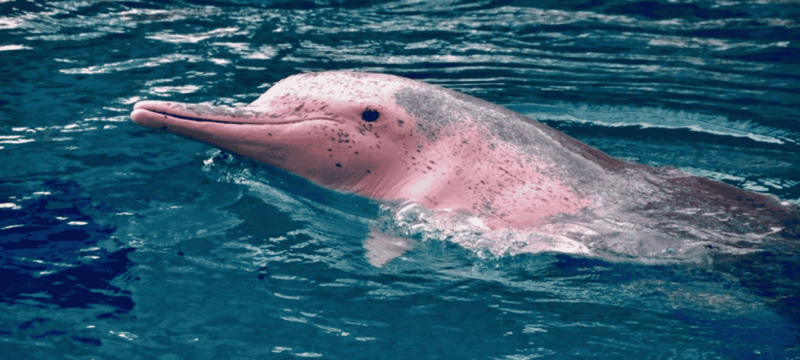The pink dolphin is one of the most unique animals in the world. It lives in rivers, especially the Amazon River. People also call it the Amazon river dolphin or boto.
This animal is rare and very special. Its pink color makes it easy to recognize. In this blog, we will explore its life, habits, threats, and how to protect it.
What Is a Pink Dolphin?
The pink dolphin is a freshwater dolphin. It belongs to a species called Inia geoffrensis. These dolphins can grow up to 8 feet long and weigh around 300 pounds.
Unlike the common gray dolphin, it has pink skin. The color can be light or bright pink. Its shade depends on age, water, and blood flow.
Pink dolphins have long snouts. They use their snouts to catch fish. They have small eyes but very good hearing.
Where Do Pink Dolphins Live?
Pink dolphins live in South America, mostly in the Amazon River and its tributaries. They are also found in the Orinoco River in Venezuela and Colombia.
These dolphins like freshwater rivers, lakes, and flooded forests. These areas give them food and protection. During the rainy season, rivers rise, and dolphins move to flooded forests.
Diet of the Pink Dolphin
Pink dolphins are carnivores. They eat fish, crabs, and small turtles. They also eat river shrimp and other small animals.
Their long snout helps them catch food. They use echolocation to find prey. Echolocation is like sonar, helping them see with sound.
Pink dolphins are smart hunters. They can hunt alone or in small groups.
Behavior and Social Life
Pink dolphins are very social. They live in small groups called pods. Groups usually have 2 to 10 dolphins.
They communicate using clicks, whistles, and squeaks. These sounds help them find food and friends. Pink dolphins are playful and curious. They often jump out of water and spin.
They are shy around humans but in some areas, they are friendly and may approach boats.
Reproduction and Lifespan
Female pink dolphins give birth to one calf at a time. Pregnancy lasts about 11 to 12 months. Calves are usually gray at birth and turn pink as they grow older.
Pink dolphins live around 20 years in the wild. Some may live longer in safe areas.
Threats to the Pink Dolphin
Pink dolphins face many dangers today. Pollution from chemicals and trash harms their health. Fishing nets can trap and kill them.
Habitat loss from dams and deforestation destroys rivers. Some local people hunt dolphins for meat. These threats make pink dolphins vulnerable. Scientists warn that their population is declining.
Conservation of Pink Dolphins
Many organizations work to protect pink dolphins. They create safe areas in rivers and forests. They teach local people to avoid hunting dolphins.
Laws in Brazil, Peru, and other countries protect them. Responsible tourism can help. Visitors should watch dolphins without disturbing them.
Fun Facts About Pink Dolphins
- Pink dolphins can be fully or partially pink.
- They sometimes swim upside down.
- They are called “botos” in local cultures.
- Their color gets brighter in shallow water.
- They are the largest river dolphins in the world.
Why Pink Dolphins Are Important
Pink dolphins help keep rivers healthy. They eat fish and maintain balance in ecosystems. They also attract tourism, which helps local communities.
Protecting them protects the entire river environment. They are more than just beautiful animals—they are a treasure of nature.
FAQs About Pink Dolphins
Q1: Are pink dolphins friendly to humans?
Yes, but they are still wild animals. Avoid touching or feeding them.
Q2: Why are they pink?
Pink color comes from blood vessels, age, and water clarity.
Q3: Can pink dolphins live in the ocean?
No, they are freshwater dolphins and cannot live in saltwater.
Q4: How many pink dolphins are left?
Exact numbers are unknown, but they are considered vulnerable.
Q5: How can I help pink dolphins?
Support conservation groups, avoid polluting rivers, and promote eco-tourism.
Conclusion
The pink dolphin is a rare and amazing animal. It is a symbol of the Amazon River’s health. Sadly, threats like pollution and hunting endanger its survival.
We can help by protecting rivers and spreading awareness. By learning about the pink dolphin, we can save it for future generations. The pink dolphin is more than a beautiful animal; it is a treasure of nature.
Also Read:WWF issues a strong condemnation of the killing of an endangered Indus River dolphin







